 Last additions - Takashima 高島市 Last additions - Takashima 高島市 |

A procession of musicians went up the steps and walked around the shrine.Jun 01, 2010
|
|

Jun 01, 2010
|
|

The horseback archer faced the shrine and gave a ritualistic prayer with a bow at 2:20 pm. He was followed by the eight horseback riders who bowed to the shrine.Jun 01, 2010
|
|

Jun 01, 2010
|
|

Yabusame horseback archer.Jun 01, 2010
|
|

Next, the horseback archer approached the shrine.Jun 01, 2010
|
|

Turned out that the umbrella holder was his papa whom he had missed.Jun 01, 2010
|
|

Jun 01, 2010
|
|

Then this cute little boy wandered in.Jun 01, 2010
|
|

Nice shoes.Jun 01, 2010
|
|

Jun 01, 2010
|
|

Jun 01, 2010
|
|

At 2 pm, they had a ceremony with the shrine priest and representatives from the eight former villages.Jun 01, 2010
|
|

The yakko-furi proceeded to the steps leading to the shrine and then dispersed.Jun 01, 2010
|
|
|

Jun 01, 2010
|
|

Jun 01, 2010
|
|

Jun 01, 2010
|
|

Jun 01, 2010
|
|

Jun 01, 2010
|
|

Jun 01, 2010
|
|

Jun 01, 2010
|
|

Jun 01, 2010
|
|

Jun 01, 2010
|
|

Jun 01, 2010
|
|

Jun 01, 2010
|
|

After a triumphant return home, the Sasaki clan would perform yabusame horseback archery with 12 horses and 12 targets as an offering to the shrine. This was the beginning of this festival.Jun 01, 2010
|
|

They performed their routine twice along different sections of this horse track to enable everyone to see it. It was about 20 min. long.Jun 01, 2010
|
|

After lunch, the yakko-furi arrived at the shrine at around 1 pm.Jun 01, 2010
|
|

Nearer to the shrine, the horse track is lined with spectator seating. Apparently, people donated money for a seat to view the procession and galloping horses.Jun 01, 2010
|
|

Oarahiko Shrine was originally established to appease the god to prevent flooding from local rivers. The Sasaki clan worshipped here whenever they went off to war and when they returned triumphantly.Jun 01, 2010
|
|

Toyoki-iri-Hiko-no-Mikoto was the son of Emperor Sujin, the 10th emperor of Japan. Portable shrine is stored in the Haiden Hall during the festival.Jun 01, 2010
|
|

Oarahiko Shrine worships Toyoki-iri-Hiko-no-Mikoto (豊城入彦命), Oaradawake-no-Mikoto (大荒田別命), and the four gods related to the Sasaki clan who ruled Omi (Shiga) in the 14th century.Jun 01, 2010
|
|
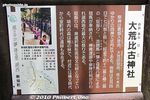
About Oarahiko Shrine in Japanese.Jun 01, 2010
|
|

Entrance to Oarahiko Shrine. The shrine was established in the 13th century. It was patronized by the Sasaki clan in the 14th century when they ruled Omi Province. MAPJun 01, 2010
|
|

First torii of Oarahiko Shrine. It's kind of far from the nearest train station of Shin-Asahi on the JR Kosei Line. Rent a bicycle from the tourist office at the train station. 大荒比古神社Jun 01, 2010
|
|

The path to the shrine also serves as the horse track (baba 馬場) for galloping horses (yabusame).Jun 01, 2010
|
|

Eight more work horses in the procession. The horses comes from the eight former villages under the shrine's tutelage. 役馬Jun 01, 2010
|
|

Yabusame horseback archer.Jun 01, 2010
|
|

The young men performing the yakko-furi come from one of the eight former villages in the area. The former villages take turns in participating in the yakko-furi procession.Jun 01, 2010
|
|

Yabusame horseback archer.Jun 01, 2010
|
|

Shichikawa Matsuri's yakko-furi dance is a Shiga Prefecture Intangible Folk Cultural Property. 滋賀県選択無形民俗文化財Jun 01, 2010
|
|

The Shichikawa Matsuri is held on the same day as the Omizo Matsuri in neighboring Omi-Takashima. So I saw the Omizo Matsuri in the morning, then rushed over to see this festival.Jun 01, 2010
|
|

Leading the procession are 12 yakko-furi men who carry the horseback archer's wooden targets. Yakko-furi were manual laborers of the samurai. 奴振りJun 01, 2010
|
|

Held annually on May 4 in Takashima, Shichikawa Matsuri is Oarahiko Shrine's biggest festival (Reisai). It starts with a procession in the shrine's neighborhood. The shrine is near Shin-Asahi Station (JR Kosei Line).Jun 01, 2010
|
|

Large, cracked rocks along the footpath.Jul 10, 2009
|
|

Jul 10, 2009
|
|

Jul 10, 2009
|
|

Osaki Camping GroundsJul 10, 2009
|
|

Jul 10, 2009
|
|

Jul 10, 2009
|
|

Jul 10, 2009
|
|

During cherry blossom season, pedestrians will walk through this dark, narrow tunnel. No sidewalks, so be careful. Cars whiz by. Best to carry a flashlight.Jul 10, 2009
|
|

Jul 10, 2009
|
|

Jul 10, 2009
|
|

Jul 10, 2009
|
|

ChikubushimaJul 10, 2009
|
|

View of Kaizu-Osaki.Jul 10, 2009
|
|

Entrance to Osaki Camp grounds.Jul 10, 2009
|
|

Soon you will reach this rest stop and the Kaizu-Osaki boat pier. Jul 10, 2009
|
|

Jul 10, 2009
|
|

Welcome sign to Makino (as seen from Nishi-Azai).Jul 10, 2009
|
|

Jul 10, 2009
|
|

Jul 10, 2009
|
|

Entrance to Osaki temple. 100 yen donations are requested.Jul 10, 2009
|
|

Jul 10, 2009
|
|

Jul 10, 2009
|
|

The trail then goes down to the Osaki Camping Grounds.Jul 10, 2009
|
|

Jul 10, 2009
|
|

Jul 10, 2009
|
|

Jul 10, 2009
|
|

Jul 10, 2009
|
|

If you're walking, there's a side path here. (Some people walk from Makino Station.)Jul 10, 2009
|
|

Jul 10, 2009
|
|

Jul 10, 2009
|
|

Jul 10, 2009
|
|

Jul 10, 2009
|
|

Kaizu-Osaki and Chikubushima islandJul 10, 2009
|
|

On weekends, the road is bumper-to-bumper traffic when the cherries are in full bloom. The road also becomes a one-way road from west to east.Jul 10, 2009
|
|

Jul 10, 2009
|
|

Jul 10, 2009
|
|

Jul 10, 2009
|
|

Jul 10, 2009
|
|
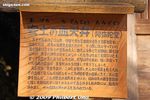
Jul 10, 2009
|
|

Jul 10, 2009
|
|

Usually it rains or storms during cherry blossom season. We were lucky in April 2009.Jul 10, 2009
|
|

Jul 10, 2009
|
|

Osaki temple 大崎寺 Jul 10, 2009
|
|

Note that the cars are bumper-to-bumper and the road has no sidewalk for pedestrians or bicycles. Be careful when walking/cycling on the road.Jul 10, 2009
|
|

The boats come from Hikone, Nagahama, and Imazu Ports during cherry blossom season.Jul 10, 2009
|
|

Jul 10, 2009
|
|
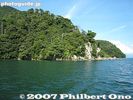
Kaizu-Osaki as seen from the lake.Jul 10, 2009
|
|

Jul 10, 2009
|
|

Jul 10, 2009
|
|

After the tunnel, some the best parts of the sakura-lined road/shore lie ahead.Jul 10, 2009
|
|

Chikubushima island and cherry blossoms at Kaizu-Osaki, Lake Biwa.Jul 10, 2009
|
|

Jul 10, 2009
|
|

Jul 10, 2009
|
|

Jul 10, 2009
|
|

Kaizu-OsakiJul 10, 2009
|
|

Across the water are more cherry trees along the Oku-Biwako Parkway road.Jul 10, 2009
|
|

Kaizu-Osaki cherry blossoms. These cherry trees were first planted in 1936 to commemorate the opening of Osaki Tunnel. Some 600 cherry trees were planted along a 4-kilometer route along the lakeshore.Jul 10, 2009
|
|

There's a slope that goes up to the temple. Jul 10, 2009
|
|

Jul 10, 2009
|
|

Jul 10, 2009
|
|

Footpath along the lake at Kaizu-Osaki.Jul 10, 2009
|
|

Jul 10, 2009
|
|

Jul 10, 2009
|
|

Jul 10, 2009
|
|
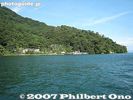
Jul 10, 2009
|
|

There are a few tunnels along the road. Jul 10, 2009
|
|

A black kite is perched in a cherry tree.Jul 10, 2009
|
|

Jul 10, 2009
|
|

Jul 10, 2009
|
|

Jul 10, 2009
|
|

Jul 10, 2009
|
|

Osaki temple 大崎寺 Jul 10, 2009
|
|

A few scenic views from the trail.Jul 10, 2009
|
|

Beyond the temple is a short trail going further north along the shore below.Jul 10, 2009
|
|

Near the boat pier is Osaki temple. Jul 10, 2009
|
|

Kaizu-Osaki and Chikubushima.Jul 10, 2009
|
|

Jul 10, 2009
|
|

Jul 10, 2009
|
|

Jul 10, 2009
|
|

The Kaizu-Osaki welcome sign marks the start of the cherry tree-lined road. Beware of cars. MAPJul 10, 2009
|
|

Jul 10, 2009
|
|

Jul 10, 2009
|
|

Kaizu-Osaki port. Cherry blossom (sakura) cruises are great because you can get to the sakura without fighting traffic.Best to take the cruise that lets you get off and walk around for 30 min. at Kaisu-Osaki Port. Better than the boats that only cruise and do not enter port.Jul 10, 2009
|
|

Jul 10, 2009
|
|

Jul 10, 2009
|
|

View of the boat pier.Jul 10, 2009
|
|

Sad to see a few cherry trees keeled over. In recent years, some trees have not been blooming so well due to sickness or age. A local NPO is trying to preserve the trees and plant new ones.Jul 10, 2009
|
|

Kaizu-Osaki cherry blossoms in northern Lake Biwa.Jul 10, 2009
|
|

These sunny photos were taken in April 2009 during a long string of sunny days right during the full bloom period.Jul 10, 2009
|
|

Kaizu-Osaki cherry blossoms, one of Japan's 100 Best Spots for cherry blossoms.Jul 10, 2009
|
|

Kaizu-Osaki Port. Boat cruises along the Kaizu-Osaki coast are offered during the cherry blossom season.Jul 10, 2009
|
|

The cherry blossom boat cruises either just cruise or they stop at Kaizu-Osaki Port where you can get off and walk around.Jul 10, 2009
|
|

Jul 10, 2009
|
|

Jul 10, 2009
|
|

Jul 10, 2009
|
|

Jul 10, 2009
|
|

Jul 10, 2009
|
|

In summer, the cherry trees are very green.Jul 10, 2009
|
|

Jul 10, 2009
|
|

Jul 10, 2009
|
|

Jul 10, 2009
|
|

Jul 10, 2009
|
|

Kaizu-Osaki is a peninsula easily accessible from Makino or Nishi-Azai Station. You can rent a bicycle at Makino Station on the Kosei Line or at Nagahara Station. Makino Station is closer so I rented a bicycle there at the tourist info office.Jul 10, 2009
|
|

You can see a line of pink along the shore of the peninsula in the distance.Jul 10, 2009
|
|

A few cherry trees along the way to Kaizu-Osaki.Jul 10, 2009
|
|

Genjihama Beach in Shin-Asahi.May 18, 2009
|
|

Genjihama BeachMay 18, 2009
|
|

May 18, 2009
|
|

May 18, 2009
|
|

May 18, 2009
|
|

Shin-Asahi manhole cover with a windmill design. Takashima, Shiga Pref.May 18, 2009
|
|

May 18, 2009
|
|

Statue of Fujimoto Tarobe'e. He pushed for the flood control of Lake Biwa by building a weir on Seta River in Otsu. 藤本太郎兵衛像 May 18, 2009
|
|

May 18, 2009
|
|
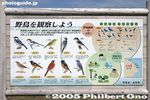
May 18, 2009
|
|

Shin Asahi Windmill Village closed in April 2016. It has been replaced with a glamping facility called STAGEX Takashima.May 18, 2009
|
|

May 18, 2009
|
|

May 18, 2009
|
|

Statue of Fujimoto Tarobe'e. 藤本太郎兵衛像 May 18, 2009
|
|

May 18, 2009
|
|

May 18, 2009
|
|

May 18, 2009
|
|

May 18, 2009
|
|

May 18, 2009
|
|

Shin Asahi Windmill Village closed in April 2016 due to aging facilities and low attendance. It has been replaced with a glamping facility called STAGEX Takashima in July 2018.May 18, 2009
|
|

May 18, 2009
|
|

Bird-watching shackMay 18, 2009
|
|

Bird-watching centerMay 18, 2009
|
|

Bird-watching area in Shin-Asahi.May 18, 2009
|
|

May 18, 2009
|
|

Shin-AsahiMay 18, 2009
|
|

Cycling path along the shore in Shin-Asahi, Takashima.May 18, 2009
|
|

May 18, 2009
|
|

May 18, 2009
|
|

May 18, 2009
|
|

May 18, 2009
|
|

Nakajima. An old fisherman departed from this dock and went around to catch fish to eat at home. He also gave a few fish to the birds which waited for him. 中島May 18, 2009
|
|

Shin-Asahi has a nice bicycle path along the lake shore.May 18, 2009
|
|

Now we are at a place called Nakajima. May 18, 2009
|
|

It then swooped down to the water and I started clicking away whether it would catch a fish or not. I was delighted to see it catch this large fish and captured the moment.May 18, 2009
|
|

Nakajima and Harie became famous in 2004 when NHK TV broadcast a program about the Harie kabata and a fisherman in Nakajima.May 18, 2009
|
|

About 100 meters offshore are two large rocks in the lake. They appear above the surface only when there is a water shortage. This little shrine with two rocks are for praying for rain. 二ツ石May 18, 2009
|
|

What a catch. It was my first time to capture a shot like this. I love these graceful and elegant birds which have a distinct cry.May 18, 2009
|
|

May 18, 2009
|
|

About Futatsu-ishi (Two Rocks).May 18, 2009
|
|

Here's a close-up of the bird's claws grasping the gills of the fish. The bird sure knows where to grab a fish. The fish had no way to escape this grip.May 18, 2009
|
|

Soon after we got to Nakajima, this black kite flew above. I tracked it with my camera. 「ピーヒョロロロロ…」May 18, 2009
|
|

Nakajima is really nice. But right behind this scene is a neighborhood of summer homes. Also see my YouTube video here.May 18, 2009
|
|

May 18, 2009
|
|

May 18, 2009
|
|

Stream with baikamoMay 18, 2009
|
|

A symbol of Harie.May 18, 2009
|
|

Kabata shed attached to a home.May 18, 2009
|
|

May 18, 2009
|
|

It had colorful koi.May 18, 2009
|
|

The heart of Harie has this waterwheel.May 18, 2009
|
|

May 18, 2009
|
|

This kabata was in a Japanese garden.May 18, 2009
|
|

Sharp Electronics once filmed a TV commercial here for their TVs.May 18, 2009
|
|

This stream with baikamo has not been muddied by the rice paddies.May 18, 2009
|
|

Underwater baikamo flowers bloom year-round since the water temperature remains almost the same.May 18, 2009
|
|

May 18, 2009
|
|

Since this kabata has small fish, a net is put over the water to prevent birds from entering.May 18, 2009
|
|

In summer, you can see more vegetables in the kabata. This means most of these homes are farmers.May 18, 2009
|
|

Snail trails. These snails are food for the fireflies in June.May 18, 2009
|
|

About this kabata. The well is 12 meters deep, water temperature is around 13 C year round.May 18, 2009
|
|

A tofu maker puts tofu in a kabata.May 18, 2009
|
|

Water quality report.May 18, 2009
|
|

Someone's outdoor kabata where we could drink the water or even put it in plastic bottles to take home.May 18, 2009
|
|

May 18, 2009
|
|

Shodenji temple also has a spring feeding this pond with various fish.May 18, 2009
|
|

Gardening seemed to be a popular pasttime in Harie. With all that free and clean water, I can think of many things to do besides gardening.May 18, 2009
|
|

Another shopping break was this fisherman's shop where you can buy ayu sweetfish caught in Lake Biwa.May 18, 2009
|
|

Can't tell in the photo, but these were the biggest carp you've ever seen.May 18, 2009
|
|

May 18, 2009
|
|

Shodenji temple belongs to the Soto Zen sect of Buddhism. 正伝寺May 18, 2009
|
|

Kabata shed of a lake fisherman.May 18, 2009
|
|

Sometimes the kabata is outdoors with no shelter.May 18, 2009
|
|

Shodenji temple's kabata. Women like this water as it feels creamy and makes their skin feel smooth and soft.May 18, 2009
|
|

May 18, 2009
|
|

May 18, 2009
|
|
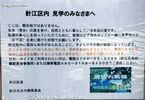
Sign saying that Harie is not a tourist spot, that a guide is required to see the kabata.May 18, 2009
|
|

Shodenji templeMay 18, 2009
|
|

Shodenji temple has its own spring spewing drinkable water.May 18, 2009
|
|

Roadside spring, one of the oldest and longest lasting.May 18, 2009
|
|

A shopping stop was here where they sold these model dragonflies well-balanced on its nose, called Kabata Tonbo.May 18, 2009
|
|

Roadside spring with waterwheel.May 18, 2009
|
|

Kabata shed.May 18, 2009
|
|

A roadside spring.May 18, 2009
|
|

Statue in front of JR Shin-Asahi Station east side.May 18, 2009
|
|

Road to Harie. It's about a 25 min. walk from Shin-Asahi Station. The water stream on the right was muddy to my surprise.May 18, 2009
|
|

Harie is a unique rural neighborhood where homes draw clean water from an ever-flowing spring directly from the ground into private wells called kabata. A local NPO conducts tours of the area and homes with kabata.Harie is in Takashima, Shiga, near JR Shin-Asahi Station on the Kosei Line, the gateway to Shin-Asahi and Harie. 新旭駅 MAPMay 18, 2009
|
|

May 18, 2009
|
|

A local non-proft group called Harie Shozu-no-Sato Committee conducts tours of Harie. For 1,000 yen, they will spend 90 min. to take you to see numerous kabata in private homes. Call 0740-25-6566 to make reservations. hariekabata.comOr email: shozunosato@lapis.plala.or.jpMay 18, 2009
|
|

May 18, 2009
|
|

Large carp in the roadside streams help keep the water clean by eating food scraps from washed dishes, etc.May 18, 2009
|
|

Many houses and wooden walls in Harie are black.May 18, 2009
|
|

Bird looks for its meal in the stream.May 18, 2009
|
|

On the west side of JR Shin-Asahi Station is this building where the local tourist info office is. You can rent bicycles here too.May 18, 2009
|
|

When they wash pots and pans, the koi fish eat the food scraps to keep the water clean. Also see my YouTube video here.May 18, 2009
|
|

JR Shin-Asahi Station west side.May 18, 2009
|
|

Sign points the way to Harie.May 18, 2009
|
|

The wooden walls are actually half-burnt, almost like charcoal.May 18, 2009
|
|

The tour starts at the Harie Kominkan community center. They don't have English-speaking guides, so bring a translator. 針江公民館May 18, 2009
|
|

Kabata shed is usually either attached to the main house or right outside it.May 18, 2009
|
|

Baikamo in Harie-Okawa RiverMay 18, 2009
|
|

Most kabata have two water sinks (ike), the one on the right (tsubo-ike) is for washing summer vegetables like tomatoes, eggplants, and cucumber. The one on the left (hata-ike) is for washing dirty root vegetables like daikon, carrots, and spinach. 川端May 18, 2009
|
|
| 995 files on 4 page(s) |
2 |  |
|